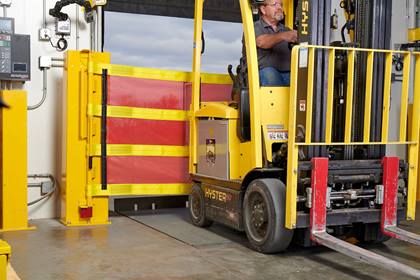RHH Hydraulic
View
Someone from our team will be in touch with you shortly.
The loading dock is a crucial hub for the seamless flow of goods, oftentimes tasking employees to outpace yesterday’s performance to keep up with increasing supply chain demands. Given the expectation of increased output in today’s fulfillment operations, it is no surprise that almost 25% of all industrial accidents take place around the loading dock. Thankfully, there are a variety of solutions to help mitigate some of the top workplace hazards negatively impacting employee safety and comfort, including dock shock, overexertion, and slips, trips, and falls. Understanding and addressing employee discomfort is paramount to helping ensure the well-being of personnel, safeguarding assets, and maintaining the efficient transfer of goods.
Dock Shock
On average, a forklift driver crosses the loading dock 100,000 times per year. One of the most common concerns for personnel safety over the period of these numerous crossings is dock shock. Dock shock is the constant jolting and jarring caused by a forklift crossing over the bumps and gaps of a traditional dock leveler, resulting in exposure to whole-body vibration. These jolts up the spine and through the neck/head area result in more than one in five forklift drivers to suffer from acute or chronic back and/or neck injuries, quite the expense considering a single back injury to a worker can cost a company $10,000 in direct and in-direct costs per injury.
Older and/or under-maintained dock levelers are the most common causes for this problem with several vibration points felt in each crossing. The first vibration point is typically located where the leveler deck meets the warehouse floor (rear hinge), while the second occurs when the lift truck passes from deck to lip (front hinge). The third vibration point is generally at the front lip edge as the forklift goes into (and especially out of) the trailer. Each point takes an extreme toll on the forklift operator’s body over time.
Dock shock has not gone unnoticed, and many facilities are committed to change. The National Safety Council unveiled the MSD Pledge initiative in 2022, which states that a company will strive to create a safer workplace and reduce musculoskeletal disorder (MSD) risk and injuries by 25% by 2025. More than 170 organizations have joined the cause.
Overexertion
Overexertion typically results in excessive physical effort or strain and can take a toll on a worker's body as well as the productivity of the business, with each injury averaging around 71 missed workdays. Whether lifting, pushing, pulling, or performing repetitive tasks, overexertion can lead to musculoskeletal injuries, fatigue, and a decline in overall employee comfort.
In addition, there are two trends that introduce a unique set of challenges to this ergonomic issue: an aging workforce as well as inexperienced, and unskilled employees. With the average worker’s age over 65 years old and experience of 80% of current loading dock workers under 2 years, this combination of an aging, yet short-tenured workforce has led to some concerning safety issues.
Slips, Trips and Falls
Slips, trips, and falls consistently rank at the top of OSHA's annual workplace injury lists and are among the most frequently cited safety violations, occurring at a rate of 27 incidents per 100,000 workers. It not only stands as the second leading cause of workers' compensation claims but is also, on average, 35% more expensive than other types of claims. Depending on the height of a fall, the consequences can be life-altering.
Falls from loading dock openings are one of the most common types of forklift accidents. In fact, approximately 7,000 such incidents occur every year. Considering most of these falls are more than 4 feet, the damage to equipment, product and workers can be catastrophic.
The Rite Solutions.
All of these potential dangers at the loading dock can lead to serious employee discomfort and injuries. However, Rite-Hite® offers a wide portfolio of industry-leading solutions that address each of these unsafe and all-too-common loading dock scenarios.
Dock shock can lead to neck and back injuries, absenteeism, and hefty medical bills. To help solve for this issue at the loading dock Rite-Hite has developed the Smooth Transition Dok System® to combat the pain points that contribute to Whole Body Vibration.
Manual, repetitive tasks can also lead to employee discomfort and serious injuries. However, facilities can take preventative steps towards reducing, eliminating, or automating these back breaking processes.
Helping protect the 4’ drop off for material handling equipment and pedestrians is a critical part of keeping the loading dock safe.

Rite Here for You.
Loading docks play a critical role in the seamless operation of the supply chain, which is why it is crucial to acknowledge and address the inherent dangers associated within these busy areas. By implementing the right loading dock equipment and safety measures, facilities can strike a balance between productivity and protection. Contact your sales representative today to learn more about how you can proactively create a more ergonomic loading dock, protecting your people, protects, and equipment.

Fill out the form below and one of our reps will reach out to you.
Someone from our team will be in touch with you shortly.